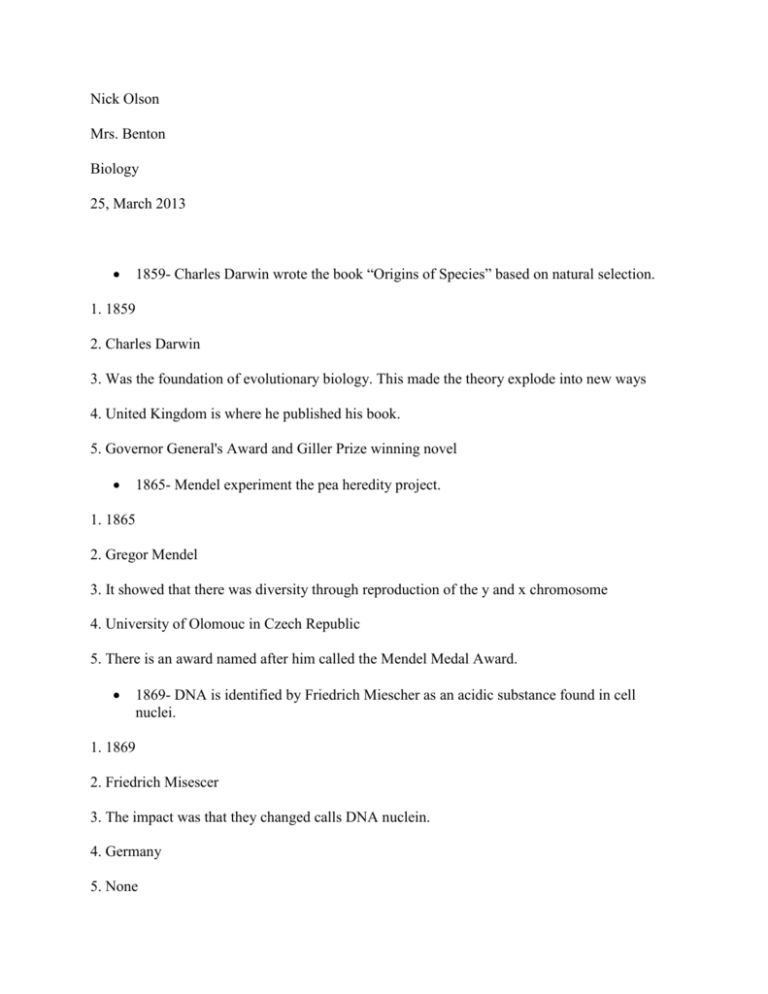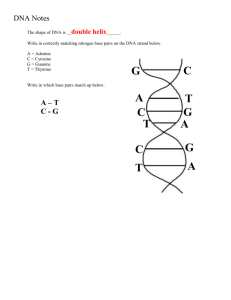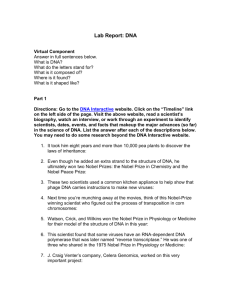bio dna day - WordPress.com
advertisement

Nick Olson Mrs. Benton Biology 25, March 2013 1859- Charles Darwin wrote the book “Origins of Species” based on natural selection. 1. 1859 2. Charles Darwin 3. Was the foundation of evolutionary biology. This made the theory explode into new ways 4. United Kingdom is where he published his book. 5. Governor General's Award and Giller Prize winning novel 1865- Mendel experiment the pea heredity project. 1. 1865 2. Gregor Mendel 3. It showed that there was diversity through reproduction of the y and x chromosome 4. University of Olomouc in Czech Republic 5. There is an award named after him called the Mendel Medal Award. 1869- DNA is identified by Friedrich Miescher as an acidic substance found in cell nuclei. 1. 1869 2. Friedrich Misescer 3. The impact was that they changed calls DNA nuclein. 4. Germany 5. None 1879- Walter Flemming describes chromosome behavior during animal cell division. He stains chromosomes to observe them clearly and describes the whole process of mitosis in 1882. 1. 2. 3. 4. 5. 1879 Walter flemming He was the first scientist to describe chromosome behavior for animal cell division. University of Prague in Germany None 1902- A human disease is first attributed to genetic causes 1. 1902 2. Sir Archibald Garrod 3. This helped scientist and doctor’s figure out that cancer can be genetic through generations. 4. London, England 5. He received honorary degrees from the universities of Aberdeen, Dublin, Glasgow, Malta, and Padua. In 1935 he was awarded the Gold Medal of the Royal Society of Medicine. 1905 The word "genetics" is introduced by William Bateson 1. 1905 2. William Bateson 3. This created more diverse thinking in evolution and in DNA. Scientist wanted to learn more about heredity as well. 4. Cambridge in England 5. Won the Darwin Medal in 1904 and then the Royal Medal in 1920 1910-11 the chromosome theory of heredity is confirmed in studies of fly eye color inheritance by T.H. Morgan and his other colleagues. 1. 2. 3. 4. 1910-11 T.H Morgan This showed diverse organisms eye color in which not just human can see color Colombia Ohio 5. Nobel Prize piece, Darwin Medal, and the science institution made a medal after his name. 1925-27 H. Muller shows that X-rays induce mutations in a dose-dependent fashion 1. 2. 3. 4. 5. 1950 In DNA, there are equal amounts of A and T, and equal amounts of C and G, as shown by Erwin Chargaff. 1. 2. 3. 4. 5. 1925 H. Muller His theory that nuclear and radiation can cause cancer and death. Houston Texas at Rice University In 1946 Muller was awarded the Nobel Prize in Physiology or Medicine and he was awarded the Linnean Society of London's prestigious Darwin-Wallace Medal in 1958. 1950 Erwin Chargaff He discovered that bond A bonds with T and bond C bonds with G Colombia University in Ohio Pasteur Medal and the National Medal of Science 1953 DNA is in the shape of a double helix with antiparallel nucleotide chains and specific base pairing 1. 1953 2. Watson and Crick 3. The discovery of the Double Helix started our deep understanding of Molecular Biology when Crick proposed that the principal function of genes. 4. Both studied this in Chicago, Illinois but discovered the double helix in Belgium on April 8, 1953 5. both awarded the 1962 Nobel Prize in Physiology or Medicine 1970 The first restriction enzyme is purified by Hamilton Smith 1. 1970 2. Hamilton Smith 3. Scientist finally understood what restriction enzymes were and what they did in the process of DNA. 4. Switzerland 5. Awards: Nobel Prize in Physiology or Medicine 1972-73 Recombinant DNA is first constructed by Cohen and Boyer 1. 1972-72 2. Cohen and Boyer 3. This allowed scientist to see molecules and DNA sequences that result from the use of laboratory methods (molecular cloning) to bring together genetic material from multiple sources, creating sequences that would not otherwise be found in biological organisms. 4. New York 5. Cohen: 2010 Cohen won the Presidential Early Career Award for Scientists and Engineers under the Department of Defense and a New Innovator Award from the National Institute of Health. Boyer: National Medal of Science. 1977 DNA sequencing technology is developed by Fred Sanger 1. 1977 2. Fred Sanger 3. This allowed scientist to analyze more advancements in DNA and being able to see more of what DNA is. 4. Cornell in New York 5. Nobel Prize in Chemistry (1958) Copley Medal (1977)Nobel Prize in Chemistry (1980) 1986 PCR is developed by Kary Mullis 1. 1986 2. Kary Mullis 3. This allowed scientist to separate DNA according to size and the smaller stands were faster to make than bigger strands of DNA 4. Emeryville, California 5. Nobel Prize in Chemistry and Japan Prize 1987- Yeast artificial chromosome 1. 1987 2. Murray and Szostak 3. YACs are useful for the physical mapping of complex genomes and for the cloning of large genes 4. Cornell in New York 5. Nobel Prize for Physiology or Medicine, Lasker Award 1990's DNA microarrays are invented by Pat Brown and colleagues 1. 1990 2. Pat Brown 3. Scientists use DNA microarrays to measure the expression levels of large numbers of genes simultaneously or to genotype multiple regions of a genome. 4. Maryland 5. Takeda award 1990- The Human Genome Project 1. 1990 2. Aristides Patrinos 3. Identified all the approximately 20,000-25,000 genes in human DNA, and determined the sequences of the 3 billion chemical base pairs that make up human DNA. 4. US National Institutes of Health in Maryland 5. Nobel Prize piece 1996-7 The first cloning of a mammal is performed by Ian Wilmut 1. 1996 2. Ian Wilmut 3. This showed that a stomata cell could clone a mammal into an adult 4. Switzerland 5. Knighted in the New Year Honors for "services to science" 1999- Chromosome 22 Sequenced 1. 1999 2. Unknown 3. Humans normally have two copies of Chromosome 22 in each cell 4. Human genome project helped out from New York 5. Nobel Prize Piece 2010-Fossil DNA analysis may have revealed new human species 1. 2010 2. Dan Vergano 3. This showed that there may have been another type of human species before us 4. Siberia 5. None








